An AIoT Product Development Process with Integrated Sustainability and Universal Design
Abstract
1. Introduction
2. Literature Review
2.1. AIoT Technology and Market Development
2.2. The Relationship Between the AIoT and the United Nations Sustainable Development Goals
2.3. The Challenge of Inclusion in AIoT Technology Adoption
2.4. Advantages and Limitations of Applying Traditional Universal Design Principles to AIoT Product Development
3. Methodology
3.1. Phase 1: Conceptual Framework and Requirements Definition
Step 1
3.2. Phase Two: Design Concept and Decision Analysis
3.2.1. Step 2
- Questionnaire development and distribution:
- Converting Questionnaire Results:
- Calculate the weights of the design requirement criteria:
- Consistency Test:
- Weight integration:
3.2.2. Step 3
3.2.3. Step 4 to 6
3.3. Phase Three: Design and Validation
3.3.1. Step 7
3.3.2. Step 8
- Establish evaluation factors and evaluation ratings:
- Convert the questionnaire results into an evaluation matrix:
- Calculate entropy weight:
- Calculate the comprehensive evaluation:First, we calculated the entropy weight obtained in the previous step, with defined as the weighting for comprehensive evaluation. Next, fuzzy operations were performed on using Equations (12) and (13) to obtain the Fuzzy Comprehensive Evaluation of the design results. Specifically, Equation (13) refers to the calculation method used for composition operations in fuzzy mathematics. When calculating , the minimum value was taken sequentially between and , then between and , continuing until and . Finally, among these selected values, the maximum was chosen:
4. Results and Discussion
4.1. Phase 1 Experimental Results
Design Requirements
4.2. Results of the Second-Phase Experiment
4.2.1. Calculation Results of Design Requirement Weights
4.2.2. Converting Design Requirements into Specific Technical Measures
4.2.3. Design Decisions
4.3. Design Outcomes
4.4. Validation of Design Outcomes
4.5. Discussion and Findings
5. Conclusions
Author Contributions
Funding
Institutional Review Board Statement
Informed Consent Statement
Data Availability Statement
Conflicts of Interest
Appendix A. Pairwise Comparison Matrix
| Expert No. | A1 | A2 | A3 | A4 | A5 | |
|---|---|---|---|---|---|---|
| 1 | A1 | 1 | 1/4 | 1/5 | 1 | 2 |
| A2 | 4 | 1 | 1/2 | 2 | 3 | |
| A3 | 5 | 2 | 1 | 5 | 5 | |
| A4 | 1 | 1/2 | 1/5 | 1 | 1/2 | |
| A5 | 1/2 | 1/3 | 1/5 | 2 | 1 | |
| 2 | A1 | 1 | 1/5 | 1/6 | 1/2 | 1/2 |
| A2 | 5 | 1 | 1/2 | 1/2 | 1 | |
| A3 | 6 | 2 | 1 | 2 | 2 | |
| A4 | 2 | 2 | 1/2 | 1 | 1/2 | |
| A5 | 2 | 1 | 1/2 | 2 | 1 | |
| 3 | A1 | 1 | 1 | 1/2 | 2 | 1 |
| A2 | 1 | 1 | 1 | 2 | 3 | |
| A3 | 2 | 1 | 1 | 2 | 1 | |
| A4 | 1/2 | 1/2 | 1/2 | 1 | 2 | |
| A5 | 1 | 1/3 | 1 | 1/2 | 1 | |
| 4 | A1 | 1 | 5 | 1 | 3 | 1 |
| A2 | 1/5 | 1 | 1/3 | 2 | 1/2 | |
| A3 | 1 | 3 | 1 | 4 | 1 | |
| A4 | 1/3 | 1/2 | 1/4 | 1 | 1/4 | |
| A5 | 1 | 2 | 1 | 4 | 1 | |
| 5 | A1 | 1 | 3 | 1/2 | 2 | 2 |
| A2 | 1/3 | 1 | 1 | 4 | 3 | |
| A3 | 2 | 1 | 1 | 2 | 2 | |
| A4 | 1/2 | 1/4 | 1/2 | 1 | 1 | |
| A5 | 1/2 | 1/3 | 1/2 | 1 | 1 | |
| 6 | A1 | 1 | 1 | 1/2 | 2 | 2 |
| A2 | 1 | 1 | 1 | 2 | 2 | |
| A3 | 2 | 1 | 1 | 3 | 1 | |
| A4 | 1/2 | 1/2 | 1/3 | 1 | 1/2 | |
| A5 | 1/2 | 1/2 | 1 | 2 | 1 | |
| 7 | A1 | 1 | 1/5 | 1/5 | 3 | 1 |
| A2 | 5 | 1 | 1 | 5 | 4 | |
| A3 | 5 | 1 | 1 | 4 | 2 | |
| A4 | 1/3 | 1/5 | 1/4 | 1 | 1/2 | |
| A5 | 1 | 1/4 | 1/2 | 2 | 1 | |
| 8 | A1 | 1 | 4 | 1/4 | 3 | 3 |
| A2 | 1/4 | 1 | 1/2 | 2 | 2 | |
| A3 | 4 | 2 | 1 | 4 | 4 | |
| A4 | 1/3 | 1/2 | 1/4 | 1 | 2 | |
| A5 | 1/3 | 1/2 | 1/4 | 1/2 | 1 | |
| 9 | A1 | 1 | 1 | 1/3 | 7 | 5 |
| A2 | 1 | 1 | 1/2 | 4 | 6 | |
| A3 | 3 | 2 | 1 | 3 | 4 | |
| A4 | 1/7 | 1/4 | 1/3 | 1 | 1/2 | |
| A5 | 1/5 | 1/6 | 1/4 | 2 | 1 | |
| 10 | A1 | 1 | 1/5 | 1/6 | 1 | 1 |
| A2 | 5 | 1 | 1/2 | 3 | 4 | |
| A3 | 6 | 2 | 1 | 5 | 5 | |
| A4 | 1 | 1/3 | 1/5 | 1 | 1 | |
| A5 | 1 | 1/4 | 1/5 | 1 | 1 |
Appendix B. Single-Factor Evaluation Matrix
| c1 | c2 | c3 | c4 | c5 | |
|---|---|---|---|---|---|
| b1 | 0.000 | 0.025 | 0.050 | 0.575 | 0.350 |
| b2 | 0.000 | 0.075 | 0.225 | 0.525 | 0.175 |
| b3 | 0.000 | 0.100 | 0.200 | 0.600 | 0.100 |
| b4 | 0.000 | 0.000 | 0.075 | 0.625 | 0.300 |
| b5 | 0.000 | 0.025 | 0.150 | 0.675 | 0.150 |
| b6 | 0.000 | 0.000 | 0.125 | 0.700 | 0.175 |
| b7 | 0.000 | 0.025 | 0.025 | 0.575 | 0.375 |
| b8 | 0.000 | 0.025 | 0.025 | 0.625 | 0.325 |
| b9 | 0.000 | 0.000 | 0.100 | 0.625 | 0.275 |
| b10 | 0.000 | 0.000 | 0.075 | 0.775 | 0.150 |
| b11 | 0.000 | 0.050 | 0.175 | 0.600 | 0.175 |
| b12 | 0.000 | 0.050 | 0.000 | 0.625 | 0.325 |
| b13 | 0.000 | 0.025 | 0.175 | 0.575 | 0.225 |
| b14 | 0.000 | 0.075 | 0.275 | 0.575 | 0.075 |
| b15 | 0.000 | 0.050 | 0.050 | 0.625 | 0.275 |
| b16 | 0.000 | 0.025 | 0.225 | 0.600 | 0.150 |
| b17 | 0.000 | 0.025 | 0.125 | 0.700 | 0.150 |
| b18 | 0.000 | 0.000 | 0.075 | 0.725 | 0.200 |
| b19 | 0.000 | 0.000 | 0.050 | 0.600 | 0.350 |
| b20 | 0.000 | 0.000 | 0.025 | 0.700 | 0.275 |
| b21 | 0.000 | 0.025 | 0.100 | 0.675 | 0.200 |
| b22 | 0.000 | 0.000 | 0.050 | 0.600 | 0.350 |
| b23 | 0.000 | 0.000 | 0.075 | 0.675 | 0.250 |
| b24 | 0.000 | 0.000 | 0.025 | 0.725 | 0.250 |
| b25 | 0.000 | 0.050 | 0.125 | 0.625 | 0.200 |
| b26 | 0.000 | 0.000 | 0.025 | 0.700 | 0.275 |
| b27 | 0.000 | 0.000 | 0.125 | 0.675 | 0.200 |
| b28 | 0.000 | 0.000 | 0.000 | 0.725 | 0.275 |
| b29 | 0.000 | 0.025 | 0.225 | 0.525 | 0.225 |
| b30 | 0.000 | 0.025 | 0.125 | 0.550 | 0.300 |
Appendix C. Mapping of Traditional PPP to ePPP-AIoT Indicators
| Traditional Universal Design Achievement PPP Evaluation Indicators (37 Items) | Enhanced Product Performance Program for AIoT (ePPP-AIoT) Evaluation Indicators (30 Items) | Processing Method |
|---|---|---|
| UD01 Equal use | b01/b02/b03 | Expanded (Split into b01–b03) |
| UD02 Eliminate feelings of difference | b06 | Retained |
| UD03 Offering choices | b04 | Reformulated |
| UD04 Eliminate anxiety | b05 | Retained |
| UD05 Freedom of use | b04 | Consolidated into b04 |
| UD06 Accepting left/right-handed | b04 | Consolidated into b04 |
| UD07 Proper use in emergency situations | b16 | Retained |
| UD08 Usability under changing conditions | b09 | Expanded (AI-adaptive) |
| UD09 Not overly complicated | b07 | Retained |
| UD10 Intuitive to use | b08 | Retained |
| UD11 Easy to use and understand | b07 | Consolidated into b07 |
| UD12 Operating tips and feedback | b10 | Retained |
| UD13 Easy to understand structure | b12 | Reformulated |
| UD14 Provide multiple means of information transmission | b11 | Retained |
| UD15 Processed obstacle operation information | b12 | Consolidated into b12 |
| UD16 Considerations for preventing danger | b13 | Retained |
| UD17 Preventing accidents | b13 | Consolidated into b13 |
| UD18 Ensuring safety even when used incorrectly | b15 | Retained |
| UD19 Even if you fail… | b15 | Consolidated into b15 |
| UD20 Natural posture | b23 | Reformulated (Concrete form) |
| UD21 Actions that exclude meaning | — | Deleted (redundant/unclear) |
| UD22 Low physical load | b17/b18 | Expanded and Split |
| UD23 No fatigue even after prolonged use | b18 | Consolidated into b18 |
| UD24 Easy-to-use space and size | b21 | Retained (Rephrased) |
| UD25 Suitable for all body types | b21 | Consolidated into b21 |
| UD26 Caregivers can use it together | b19 | Retained |
| UD27 Easy to transport and store | — | Deleted (not applicable to AIoT appliances) |
| UD28 Durability | b26 | Consolidated into b26 |
| UD29 Reasonable price | b26 | Consolidated into b26 |
| UD30 Economy in continuous use | b26 | Consolidated into b26 |
| UD31 Easy maintenance and repair | b26 | Consolidated into b26 |
| UD32 Comfortable/attractive | b27 | Retained |
| UD33 Satisfactory quality | b28 | Retained |
| UD34 Effective use of materials | — | Deleted (integrated into b28/b29 considerations) |
| UD35 Harmless to humans | b29 | Consolidated into b29 |
| UD36 Harmless to environment | b29 | Consolidated into b29 |
| UD37 Promoting recycling and reuse | b30 | Retained |
| — | b14 Focus on network security | Newly Added (AIoT-specific) |
| — | b20 Consistent operation/interface | Newly Added (AIoT-specific) |
| — | b22 Interoperability/data integration | Newly Added (AIoT-specific) |
| — | b24 Response speed | Newly Added (AIoT-specific) |
| — | b25 Personalized recommendations | Newly Added (AIoT-specific) |
Appendix D. Three-Round Convergence Mapping of Scenarios
| Round 1: Initial Scenario Drafts (R1-S) | Round 2: Candidate Scenarios (R2-S) | Round 3: Final Representative Scenarios (S) |
|---|---|---|
| R1-S1 Expiration reminders | R2-S1 Food preservation and expiration | S1 Mother’s health management assistant |
| R1-S2 Near-expiration push notifications | R2-S1 Food preservation and expiration | S1 Mother’s health management assistant |
| R1-S3 Remote inventory checking | R2-S2 Remote collaboration and sharing | S2 Father’s remote collaboration |
| R1-S4 Shared family shopping lists | R2-S2 Remote collaboration and sharing | S2 Father’s remote collaboration |
| R1-S5 Children’s breakfast reminders | R2-S3 Child diet and lifestyle reminders | S5 Children’s breakfast reminder |
| R1-S6 Elder-friendly interface | R2-S4 Elder-friendly use | S4 Grandparents’ stress-free use |
| R1-S7 Voice interaction | R2-S4 Elder-friendly use | S4 Grandparents’ stress-free use |
| R1-S8 Recipe recommendations | R2-S5 Creative cooking and recipe support | S3 Daughter’s culinary creativity |
| R1-S9 Real-time image scanning | R2-S1 Food preservation and expiration | S1 Mother’s health management assistant |
| R1-S10 RFID-based smart recognition | R2-S1 Food preservation and expiration | S1 Mother’s health management assistant |
| R1-S11 Cross-device synchronization | R2-S2 Remote collaboration and sharing | S2 Father’s remote collaboration |
| R1-S12 Sustainability reminders | R2-S6 Sustainability and resource use | (Contributed across S1–S4, supporting S3/S4) |
| R1-S13 Family interaction notes | R2-S2 Remote collaboration and sharing | S2 Father’s remote collaboration |
| R1-S14 Learning and educational functions | R2-S3 Child diet and lifestyle reminders | S5 Children’s breakfast reminder |
| R1-S15 Energy efficiency and sustainability | R2-S6 Sustainability and resource use | (Supporting dimension, not a standalone story) |
| R1-S16 Online grocery shopping integration | R2-S2 Remote collaboration and sharing | S2 Father’s remote collaboration |
References
- Yan, J. AIoT in Smart Homes: Challenges, Strategic Solutions, and Future Directions. Highlights in Science. Eng. Technol. 2024, 87, 59–65. [Google Scholar]
- Alahi, M.E.E.; Sukkuea, A.; Tina, F.W.; Nag, A.; Kurdthongmee, W.; Suwannarat, K.; Mukhopadhyay, S.C. Integration of IoT-enabled technologies and artificial intelligence (AI) for smart city scenario: Recent advancements and future trends. Sensors 2023, 23, 5206. [Google Scholar] [CrossRef] [PubMed]
- Grand View Research. Smart Home Market Size, Share & Trends Analysis Report By Products (Lighting Control, Security & Access Controls), By Application (New Construction, Retrofit), By Protocols (Wireless, Wired), By Region, And Segment Forecasts, 20232030. 2023. Available online: https://www.grandviewresearch.com/industry-analysis/smart-homes-industry (accessed on 25 July 2025).
- Pitilakis, A.; Tsilipakos, O.; Liu, F.; Kossifos, K.M.; Tasolamprou, A.C.; Kwon, D.H.; Mirmoosa, M.S.; Manessis, D.; Kantartzis, N.V.; Liaskos, C.; et al. A multi-functional reconfigurable metasurface: Electromagnetic design accounting for fabrication aspects. IEEE Trans. Antennas Propag. 2020, 69, 1440–1454. [Google Scholar]
- Seng, K.P.; Ang, L.M.; Ngharamike, E. Artificial intelligence Internet of Things: A new paradigm of distributed sensor networks. Int. J. Distrib. Sens. Netw. 2022, 18, 15501477211062835. [Google Scholar] [CrossRef]
- Baker, S.; Xiang, W. Artificial intelligence of things for smarter healthcare: A survey of advancements, challenges, and opportunities. IEEE Commun. Surv. Tutor. 2023, 25, 1261–1293. [Google Scholar] [CrossRef]
- Anyonyi, Y.I.; Katambi, J. The Role of AI in IoT Systems: A Semi-Systematic Literature Review. Master’s Thesis, Malmö University, Malmö, Sweden, 2023. [Google Scholar]
- Zhang, J.; Tao, D. Empowering things with intelligence: A survey of the progress, challenges, and opportunities in artificial intelligence of things. IEEE Internet Things J. 2020, 8, 7789–7817. [Google Scholar] [CrossRef]
- Verma, A.; Kumar, R. IoT and AIoT: Applications, Challenges and Optimization. In The Future of Computing: Ubiquitous Applications and Technologies; Bentham Science Publishers: Sharjah, United Arab Emirates, 2024; p. 126. [Google Scholar]
- Matin, A.; Islam, M.R.; Wang, X.; Huo, H.; Xu, G. AIoT for sustainable manufacturing: Overview, challenges, and opportunities. Internet Things 2023, 24, 100901. [Google Scholar] [CrossRef]
- World Health Organization. Ageism in Artificial Intelligence for Health: WHO Policy Brief; World Health Organization: Geneva, Switzerland, 2022. [Google Scholar]
- Chu, C.H.; Nyrup, R.; Leslie, K.; Shi, J.; Bianchi, A.; Lyn, A.; McNicholl, M.; Khan, S.; Rahimi, S.; Grenier, A. Digital ageism: Challenges and opportunities in artificial intelligence for older adults. Gerontologist 2022, 62, 947–955. [Google Scholar] [CrossRef]
- Chu, C.H.; Leslie, K.; Shi, J.; Nyrup, R.; Bianchi, A.; Khan, S.S.; Rahimi, S.A.; Lyn, A.; Grenier, A. Ageism and artificial intelligence: Protocol for a scoping review. JMIR Res. Protoc. 2022, 11, e33211. [Google Scholar] [CrossRef]
- Schoppe, L.L. Digital Technologies: A Panacea or a Double-Edged Sword? Understanding the Consequences of Artificial Intelligence For Individuals, Firms and Society. Ph.D. Thesis, Goethe University Frankfurt, Frankfurt, Germany, 2022. [Google Scholar]
- Grinin, L.; Grinin, A.; Korotayev, A. Global Aging: An Integral Problem of the Future. How to Turn a Problem into a Development Driver? In Reconsidering the Limits to Growth: A Report to the Russian Association of the Club of Rome; Springer International Publishing: Cham, Switzerland, 2023; pp. 117–135. [Google Scholar]
- Grinin, L.; Grinin, A.; Korotayev, A. Global aging and our futures. World Futures 2023, 79, 536–556. [Google Scholar]
- Stawarz, K.; Katz, D.; Ayobi, A.; Marshall, P.; Yamagata, T.; Santos-Rodriguez, R.; Flach, P.; O’kAne, A.A. Co-designing opportunities for Human-Centred Machine Learning in supporting Type 1 diabetes decision-making. Int. J. Hum.-Comput. Stud. 2023, 173, 103003. [Google Scholar] [CrossRef]
- de Saint Priest, O.; Krings, F. The impact of diversity statements on age diversity: More than just window-dressing? Work. Aging Retire. 2024, 11, waae012. [Google Scholar] [CrossRef]
- Yang, A.J.; Xu, H.; Ding, Y.; Liu, M. Unveiling the dynamics of team age structure and its impact on scientific innovation. Scientoindicators 2024, 129, 6127–6148. [Google Scholar] [CrossRef]
- Findlay, M.; Seah, J.; Wong, W. AI and Big Data: Disruptive Regulation; Edward Elgar Publishing: Cheltenham, UK, 2023. [Google Scholar]
- Alsharif, M.H.; Jahid, A.; Kelechi, A.H.; Kannadasan, R. Green IoT: A review and future research directions. Symmetry 2023, 15, 757. [Google Scholar] [CrossRef]
- Pouresmaieli, M.; Ataei, M.; Taran, A. Future mining based on internet of things (IoT) and sustainability challenges. Int. J. Sustain. Dev. World Ecol. 2023, 30, 211–228. [Google Scholar] [CrossRef]
- Su-Fen, Y.O.U.; Pey-Chun, P.A.N. Analysis of the Development and Application of Sports Assistive Devices for People with Disabilities: A Case Study of Gait Training Machine Usage Experience. Int. J. Soc. Work. Soc. Welf. 2023, 20, 89–132. [Google Scholar]
- Celestino, S.; Garofano, A.; Masiello, B.; Izzo, F.; Bonetti, E. Disability and marketing: A bibliometric analysis and systematic literature review. Ital. J. Mark. 2024, 2024, 311–337. [Google Scholar] [CrossRef]
- Ye, L.; Wang, Z.; Jia, T.; Ma, Y.; Shen, L.; Zhang, Y.; Li, H.; Chen, P.; Wu, M.; Liu, Y.; et al. Research progress on low-power artificial intelligence of things (AIoT) chip design. Sci. China Inf. Sci. 2023, 66, 200407. [Google Scholar] [CrossRef]
- Muhammed, D.; Ahvar, E.; Ahvar, S.; Trocan, M.; Montpetit, M.J.; Ehsani, R. Artificial Intelligence of Things (AIoT) for smart agriculture: A review of architectures, technologies and solutions. J. Netw. Comput. Appl. 2024, 228, 103905. [Google Scholar] [CrossRef]
- Varalakshmi, K.; Kumar, J. Optimized predictive maintenance for streaming data in industrial IoT networks using deep reinforcement learning and ensemble techniques. Sci. Rep. 2025, 15, 27201. [Google Scholar] [CrossRef]
- Marengo, A. Navigating the nexus of AI and IoT: A comprehensive review of data analytics and privacy paradigms. Internet Things 2024, 27, 101318. [Google Scholar] [CrossRef]
- Pise, A.A.; Almuzaini, K.K.; Ahanger, T.A.; Farouk, A.; Pant, K.; Pareek, P.K.; Nuagah, S.J. Enabling Artificial Intelligence of Things (AIoT) Healthcare Architectures and Listing Security Issues. Comput. Intell. Neurosci. 2022, 2022, 8421434. [Google Scholar] [CrossRef] [PubMed] [PubMed Central]
- Omrany, H.; Al-Obaidi, K.M.; Hossain, M.; Alduais, N.A.M.; Al-Duais, H.S.; Ghaffarianhoseini, A. IoT-enabled smart cities: A hybrid systematic analysis of key research areas, challenges, and recommendations for future direction. Discov. Cities 2024, 1, 2. [Google Scholar] [CrossRef]
- Bibri, S.E.; Krogstie, J.; Kaboli, A.; Alahi, A. Smarter eco-cities and their leading-edge artificial intelligence of things solutions for environmental sustainability: A comprehensive systematic review. Environ. Sci. Ecotechnol. 2024, 19, 100330. [Google Scholar] [CrossRef] [PubMed]
- Mohsen, B.M. AI-Driven Optimization of Urban Logistics in Smart Cities: Integrating Autonomous Vehicles and IoT for Efficient Delivery Systems. Sustainability 2024, 16, 11265. [Google Scholar] [CrossRef]
- Zonta, T.; Da Costa, C.A.; da Rosa Righi, R.; de Lima, M.J.; Da Trindade, E.S.; Li, G.P. Predictive maintenance in the Industry 4.0: A systematic literature review. Comput. Ind. Eng. 2020, 150, 106889. [Google Scholar] [CrossRef]
- Achouch, M.; Dimitrova, M.; Ziane, K.; Sattarpanah Karganroudi, S.; Dhouib, R.; Ibrahim, H.; Adda, M. On Predictive Maintenance in Industry 4.0: Overview, Models, and Challenges. Appl. Sci. 2022, 12, 8081. [Google Scholar] [CrossRef]
- Shaik, T.; Tao, X.; Higgins, N.; Li, L.; Gururajan, R.; Zhou, X.; Acharya, U.R. Remote patient monitoring using artificial intelligence: Current state, applications, and challenges. Wiley Interdiscip. Rev. Data Min. Knowl. Discov. 2023, 13, e1485. [Google Scholar] [CrossRef]
- Uriarte-Gallastegi, N.; Arana-Landín, G.; Landeta-Manzano, B.; Laskurain-Iturbe, I. The Role of AI in Improving Environmental Sustainability: A Focus on Energy Management. Energies 2024, 17, 649. [Google Scholar] [CrossRef]
- MarketsandMarkets. AIoT Market by Technology and Platforms: Global Forecast to 2030 [Market Research Report]. MarketsandMarkets, 28 January 2025. Available online: https://www.marketsandmarkets.com/Market-Reports/ai-in-iot-market-43388726.html (accessed on 10 July 2025).
- Lampropoulos, G.; Garzón, J.; Misra, S.; Siakas, K. The Role of Artificial Intelligence of Things in Achieving Sustainable Development Goals: State of the Art. Sensors 2024, 24, 1091. [Google Scholar] [CrossRef] [PubMed] [PubMed Central]
- Alzahrani, A.; Kostkova, P.; Alshammari, H.; Habibullah, S.; Alzahrani, A. Intelligent integration of AI and IoT for advancing ecological health, medical services, and community prosperity. Alex. Eng. J. 2025, 127, 522–540. [Google Scholar] [CrossRef]
- Cheng, L.-K. Whether consumers prefer human or robot financial advisors: The moderating effect of self-control and agency–communion orientation. Behav. Inf. Technol. 2025, 1–14. [Google Scholar] [CrossRef]
- Bentley, S.V.; Naughtin, C.K.; McGrath, M.J.; Irons, J.L.; Cooper, P.S. The digital divide in action: How experiences of digital technology shape future relationships with artificial intelligence. AI Ethics 2024, 4, 901–915. [Google Scholar] [CrossRef]
- Zhou, J.; Salvendy, G.; Boot, W.R.; Charness, N.; Czaja, S.; Gao, Q.; Holzinger, A.; Ntoa, S.; Rau, P.-L.P.; Rogers, W.A.; et al. Grand challenges of smart technology for older adults. Int. J. Hum.—Comput. Interact. 2025, 41, 4439–4481. [Google Scholar]
- Lin, X.Y.; Moxley, J.; Sharit, J.; Czaja, S.J. Beyond the Digital Divide: Factors Associated With Adoption of Technologies Related to Aging in Place. J. Appl. Gerontol. 2025, 44, 959–969. [Google Scholar] [CrossRef] [PubMed] [PubMed Central]
- Fakhimi, M.M.; Hughes, A.; Gustavson, A.M. Evaluating Smart Home Usability and Accessibility in Early Detection and Intervention of Mental Health Challenges Among Older Adults: A Narrative Review and Framework. J. Ageing Longev. 2025, 5, 3. [Google Scholar] [CrossRef]
- Wong, A.K.C.; Lee, J.H.T.; Zhao, Y.; Lu, Q.; Yang, S.; Hui, V.C.C. Exploring older adults’ perspectives and acceptance of ai-driven health technologies: Qualitative study. JMIR Aging 2025, 8, e66778. [Google Scholar] [CrossRef]
- Lim, C.-K.; Chen, H.-Y.; Chen, X.-Y. A Seamless Technology Integration Framework for Elderly-Centered Interactive Systems: Design, Implementation, and Validation Through the Pillow Fight System. Appl. Sci. 2024, 14, 11306. [Google Scholar] [CrossRef]
- Mannheim, I.; Schwartz, E.; Xi, W.; Buttigieg, S.C.; McDonnell-Naughton, M.; Wouters, E.J.M.; van Zaalen, Y. Inclusion of Older Adults in the Research and Design of Digital Technology. Int. J. Environ. Res. Public Health 2019, 16, 3718. [Google Scholar] [CrossRef]
- Schulz, T.; Fuglerud, K.S.; Arfwedson, H.; Busch, M. A case study for universal design in the internet of things. In Universal Design 2014: Three Days of Creativity and Diversity; IOS Press: Amsterdam, The Netherlands, 2014; pp. 45–54. [Google Scholar]
- Tauke, B. The evolution of universal design. Informationen Zur Raumentwickl. 2019, 5, 36–41. [Google Scholar]
- Sheu, D.D.; Lee, H.K. A Proposed Classification and Process of Systematic Innovation. Int. J. Syst. Innov. 2010, 1, 3–22. [Google Scholar]
- Null, R. Commentary on universal design. Hous. Soc. 2003, 30, 109–118. [Google Scholar] [CrossRef]
- Klaus, P.; Edwards, K.; Norvik, D.; Manthiou, A.; Luong, V.H. Inclusive servicescapes: The imperative of universal design principles. J. Serv. Mark. 2024, 38, 1089–1098. [Google Scholar] [CrossRef]
- Bai, A.; Mork, H.C.; Halbach, T.; Fuglerud, K.S.; Leister, W.; Schulz, T. A review of universal design in ambient intelligence environments. In Proceedings of the Smart Accessibility 2016: The First International Conference on Universal Accessibility in the Internet of Things and Smart Environments, Nice, France, 24–28 July 2016; pp. 6–11. [Google Scholar]
- Yao, Y.; Huang, L.; He, Y.; Ma, Z.; Xu, X.; Mi, H. Reviewing and reflecting on smart home research from the human-centered perspective. In Proceedings of the 2023 CHI Conference on Human Factors in Computing Systems, Hamburg, Germany, 23–28 April 2023; pp. 1–21. [Google Scholar]
- Zhang, T.; Che Me, R.; Alli, H. The Usability Issues Encountered in the Design Features of Intelligent Products for Older Adults in China: A Scoping Review. Sustainability 2023, 15, 4372. [Google Scholar] [CrossRef]
- Garibay, O.O.; Winslow, B.; Andolina, S.; Antona, M.; Bodenschatz, A.; Coursaris, C.; Falco, G.; Fiore, S.M.; Garibay, I.; Grieman, K.; et al. Six human-centered artificial intelligence grand challenges. Int. J. Hum.—Comput. Interact. 2023, 39, 391–437. [Google Scholar] [CrossRef]
- Eubank, B.H.; Mohtadi, N.G.; Lafave, M.R.; Wiley, J.P.; Bois, A.J.; Boorman, R.S.; Sheps, D.M. Using the modified Delphi method to establish clinical consensus for the diagnosis and treatment of patients with rotator cuff pathology. BMC Med. Res. Methodol. 2016, 16, 56. [Google Scholar] [CrossRef] [PubMed]
- Thangaratinam, S.; Redman, C.W. The delphi technique. Obstet. Gynaecol. 2005, 7, 120–125. [Google Scholar] [CrossRef]
- Sisay, T.; Tesfaye, G.; Jothimani, M.; Reda, T.M.; Tadese, A. Landslide susceptibility mapping using combined geospatial, FR and AHP models: A case study from Ethiopia’s highlands. Discov. Sustain. 2024, 5, 474. [Google Scholar] [CrossRef]
- Das, U.; Behera, B. Geospatial assessment of ecological vulnerability of fragile Eastern Duars Forest integrating GIS-based AHP, CRITIC and AHP-TOPSIS models. Geomat. Nat. Hazards Risk 2024, 15, 2330529. [Google Scholar] [CrossRef]
- Yu, S.; Liu, M.; Chen, L.; Chen, Y.; Yao, L. Emotional Design and Evaluation of Children’s Furniture Based on AHP-TOPSIS. BioResources 2024, 19, 7418–7433. [Google Scholar] [CrossRef]
- Dong, F.; Yin, J.; Xiang, J.; Chang, Z.; Gu, T.; Han, F. EWM-FCE-ODM-based evaluation of smart community construction: From the perspective of residents’ sense of gain. Sustainability 2023, 15, 6587. [Google Scholar] [CrossRef]
- Shen, N.; Guo, X.; Cui, J.; Wu, Z. Assessment of urban community emergency preparedness and response capacity using entropy weight method and multilayer fuzzy comprehensive model. Teh. Vjesn. 2024, 31, 843–850. [Google Scholar]
- Liu, S.-F.; Chang, J.-F.; Wang, M.-H. Mask Design for Life in the Midst of COVID-19. Sustainability 2021, 13, 8011. [Google Scholar] [CrossRef]
- Liu, S.-F.; Chang, J.-F.; Hsiao, Y.-T.; Wu, C.-H. Smart Tea Utensil Design for Improving Beginners’ Tea Brewing Experience. Sustainability 2023, 15, 15044. [Google Scholar] [CrossRef]
- Zallio, M.; Ike, C.B.; Chivăran, C. Designing Artificial Intelligence: Exploring Inclusion, Diversity, Equity, Accessibility, and Safety in Human-Centric Emerging Technologies. AI 2025, 6, 143. [Google Scholar] [CrossRef]
- Kronlid, C.; Brantnell, A.; Elf, M.; Borg, J.; Palm, K. Sociotechnical analysis of factors influencing IoT adoption in healthcare: A systematic review. Technol. Soc. 2024, 78, 102675. [Google Scholar] [CrossRef]
- Zhou, C.; Dai, Y.; Huang, T.; Zhao, H.; Kaner, J. An empirical study on the influence of smart home interface design on the interaction performance of the elderly. Int. J. Environ. Res. Public Health 2022, 19, 9105. [Google Scholar] [CrossRef]
- Wang, Y.; Li, J.; Zhang, G.; Li, Y.; Asare, M.H. Fuzzy evaluation of comprehensive benefit in urban renewal based on the perspective of core stakeholders. Habitat Int. 2017, 66, 163–170. [Google Scholar] [CrossRef]
- Song, Y.; Weisberg, L.R.; Zhang, S.; Tian, X.; Boyer, K.E.; Israel, M. A framework for inclusive AI learning design for diverse learners. Comput. Educ. Artif. Intell. 2024, 6, 100212. [Google Scholar] [CrossRef]
- Choma, J.; Zaina, L. Investigating quality aspects for UX evaluation of IoT-based applications in smart cities: A literature review. Sci. Comput. Program. 2025, 245, 103319. [Google Scholar] [CrossRef]
- Adli, H.K.; Remli, M.A.; Wan Salihin Wong, K.N.S.; Ismail, N.A.; González-Briones, A.; Corchado, J.M.; Mohamad, M.S. Recent Advancements and Challenges of AIoT Application in Smart Agriculture: A Review. Sensors 2023, 23, 3752. [Google Scholar] [CrossRef]
- Suri, J.F.; Marsh, M. Scenario building as an ergonomics method in consumer product design. Appl. Ergon. 2000, 31, 151–157. [Google Scholar] [CrossRef] [PubMed]
- Anggreeni, I.; van der Voort, M.C. Tracing the Scenarios in Scenario-Based Product Design: A Study to Support Scenario Generation; Centre for Telematics and Information Technology, University of Twente: Enschede, The Netherlands, 2007. [Google Scholar]
- Immawan, T.; Saputro, D.B.; Cahyo, W.N. Design and construction of sago rasper (As business process re-engineering of sago flour). In MATEC Web of Conferences; EDP Sciences: Les Ulis, France, 2018; Volume 221, p. 02006. [Google Scholar]
- Van De Poel, I. Methodological problems in QFD and directions for future development. Res. Eng. Des. 2007, 18, 21–36. [Google Scholar] [CrossRef]
- Peruzzini, M.; Marilungo, E.; Germani, M. A QFD-based methodology to support product-service design in manufacturing industry. In Proceedings of the 2014 International Conference on Engineering, Technology and Innovation (ICE), Bergamo, Italy, 23–25 June 2014; pp. 1–7. [Google Scholar]
- Kruhlov, V.; Dvorak, J. Social Inclusivity in the Smart City Governance: Overcoming the Digital Divide. Sustainability 2025, 17, 5735. [Google Scholar] [CrossRef]
- Brooke, J. SUS-A quick and dirty usability scale. Usability Eval. Ind. 1996, 189, 4–7. [Google Scholar]
- Lee, S.C.; Yoon, S.H.; Ji, Y.G. Modeling task completion time of in-vehicle information systems while driving with keystroke level modeling. Int. J. Ind. Ergon. 2019, 72, 252–260. [Google Scholar] [CrossRef]
- Saqib, M.; Mehta, D.; Yashu, F.; Malhotra, S. Adaptive Security Policy Management in Cloud Environments Using Reinforcement Learning. arXiv 2025, arXiv:2505.08837. [Google Scholar] [CrossRef]
- Mani, Z.; Chouk, I. Drivers of consumers’ resistance to smart products. J. Mark. Manag. 2017, 33, 76–97. [Google Scholar] [CrossRef]
- Magara, T.; Zhou, Y. Internet of things (IoT) of smart homes: Privacy and security. J. Electr. Comput. Eng. 2024, 2024, 7716956. [Google Scholar] [CrossRef]
- Chou, S.K.; Hribar, J.; Mohorčič, M.; Fortuna, C. The energy cost of artificial intelligence of things lifecycle. arXiv 2024, arXiv:2408.00540v1. [Google Scholar] [CrossRef]
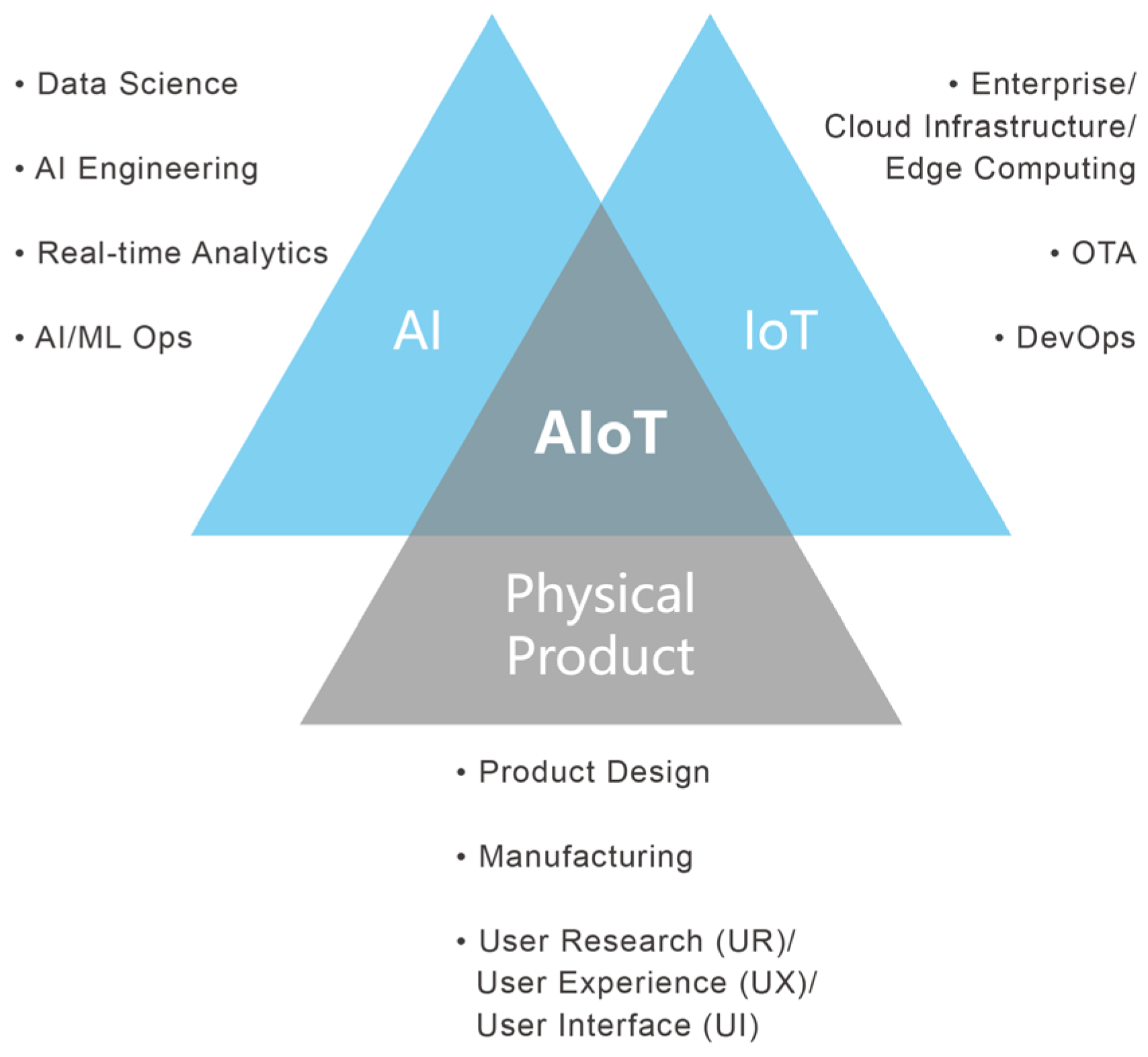
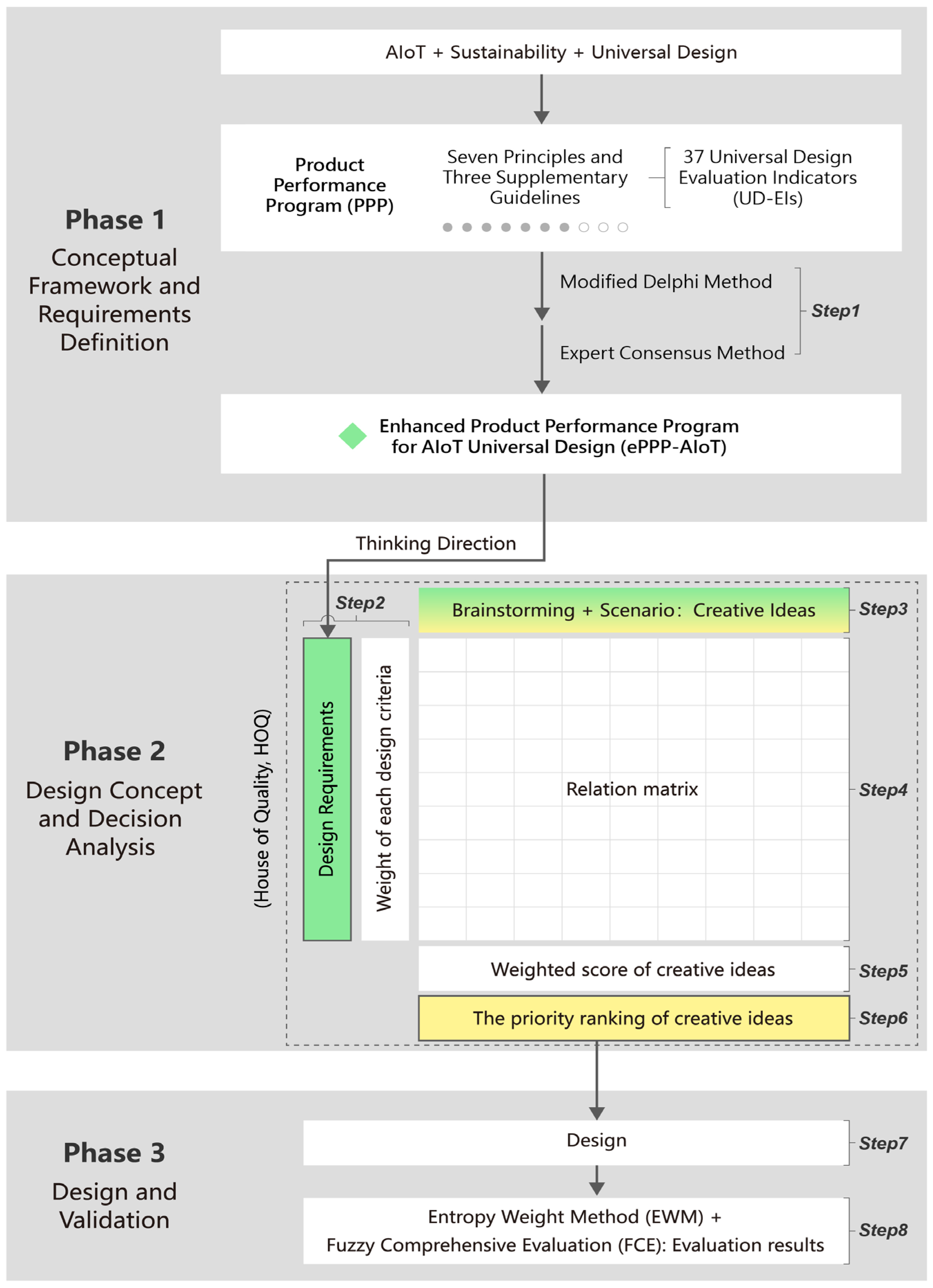

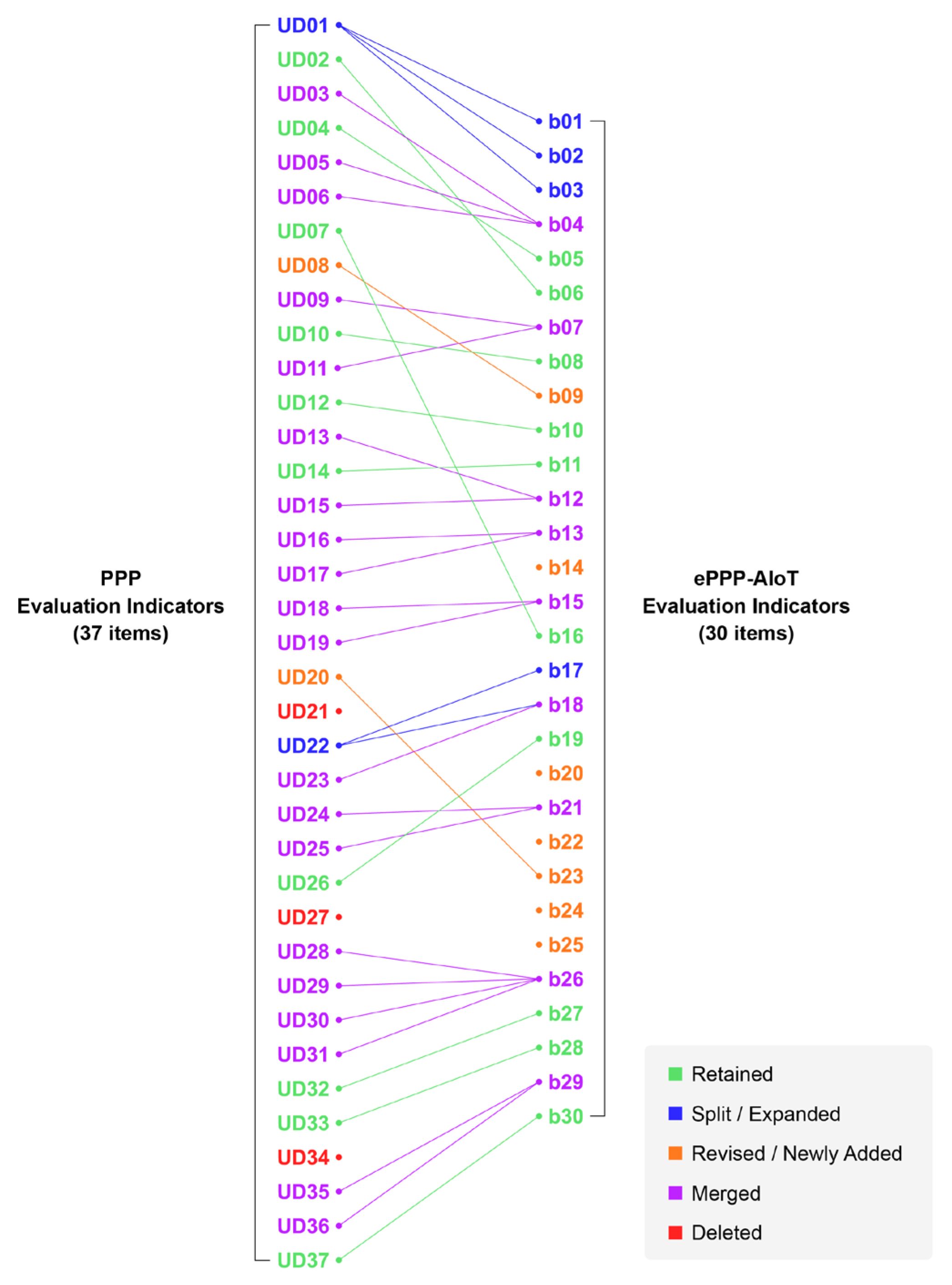
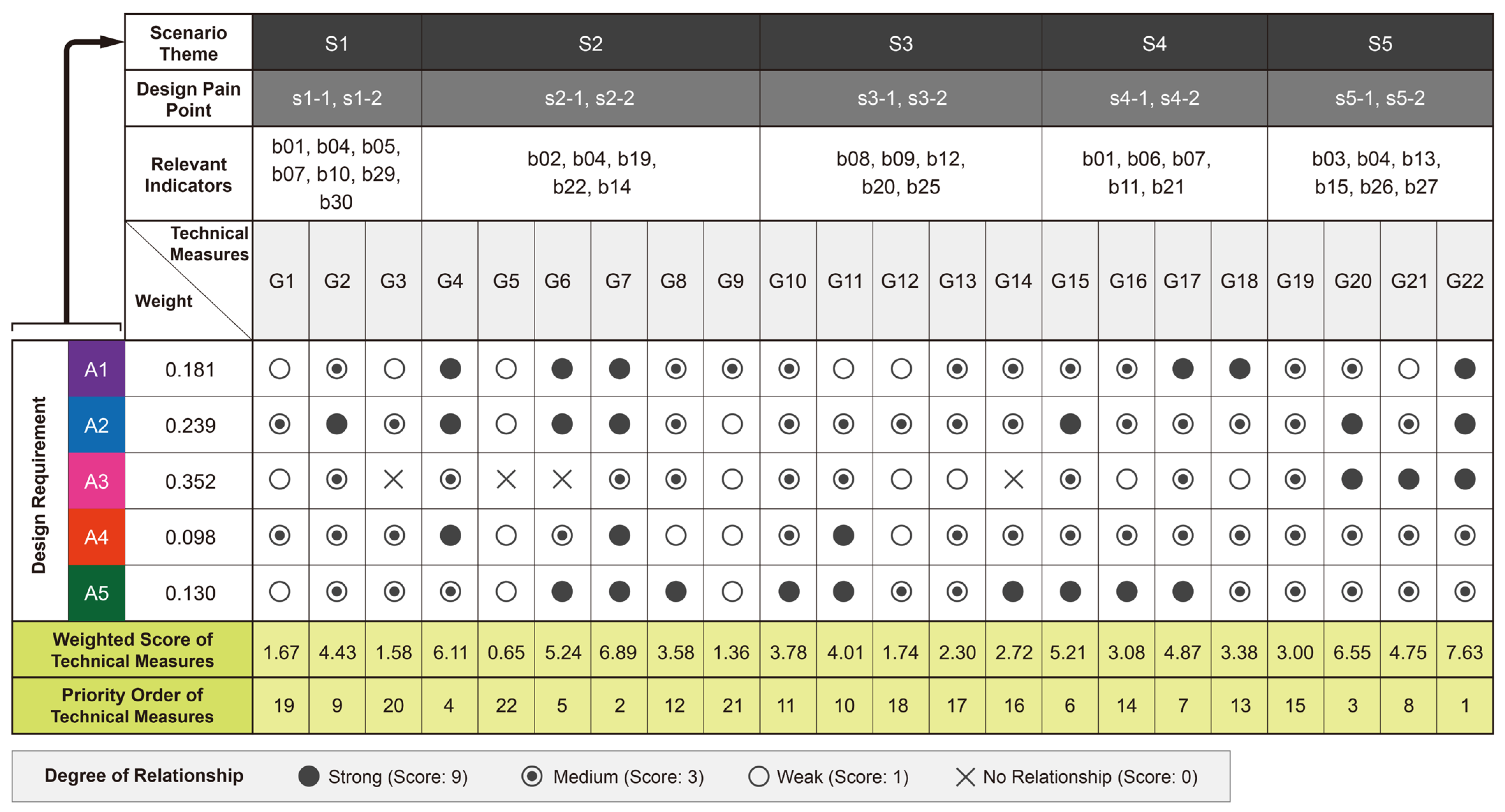
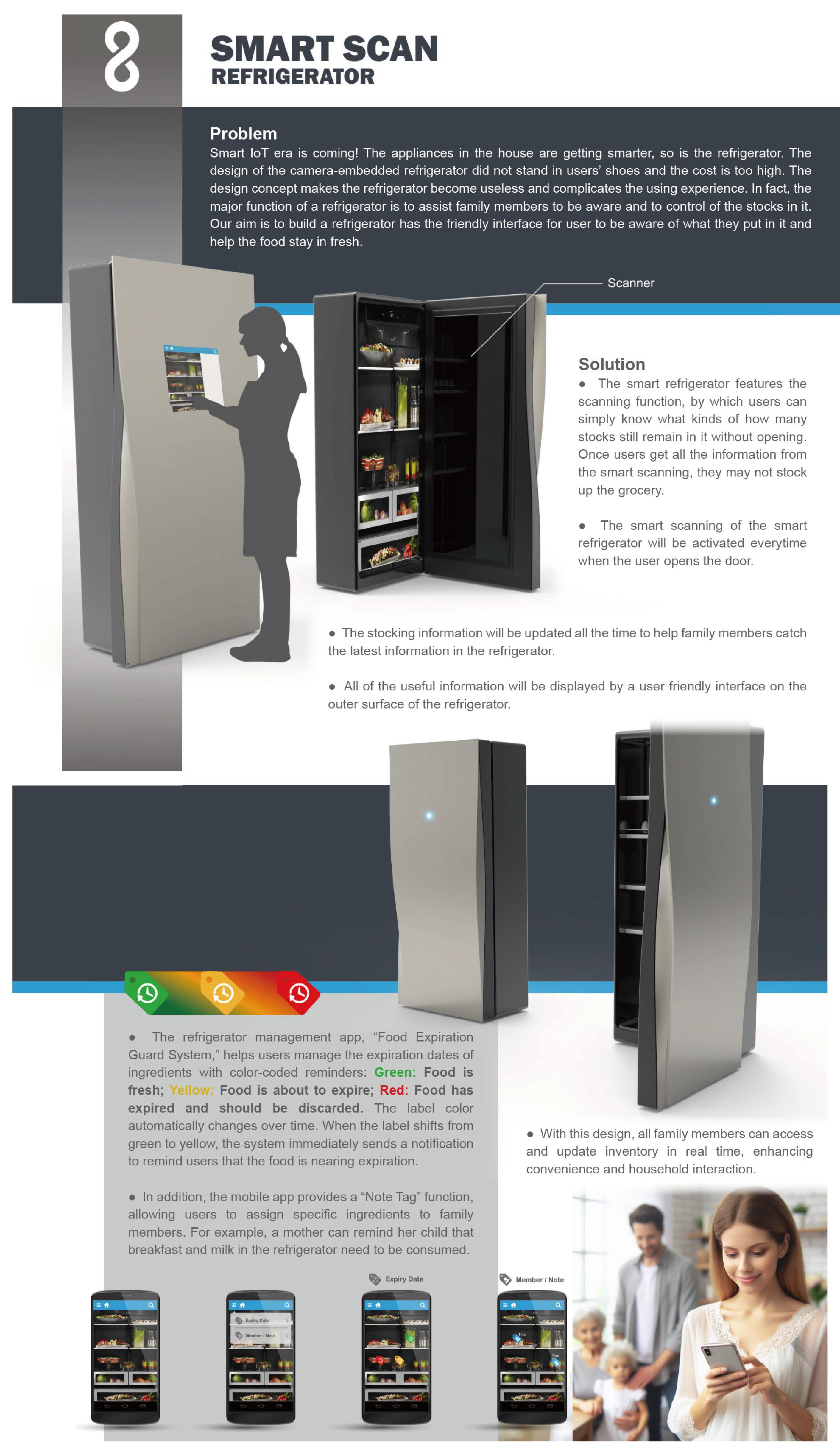

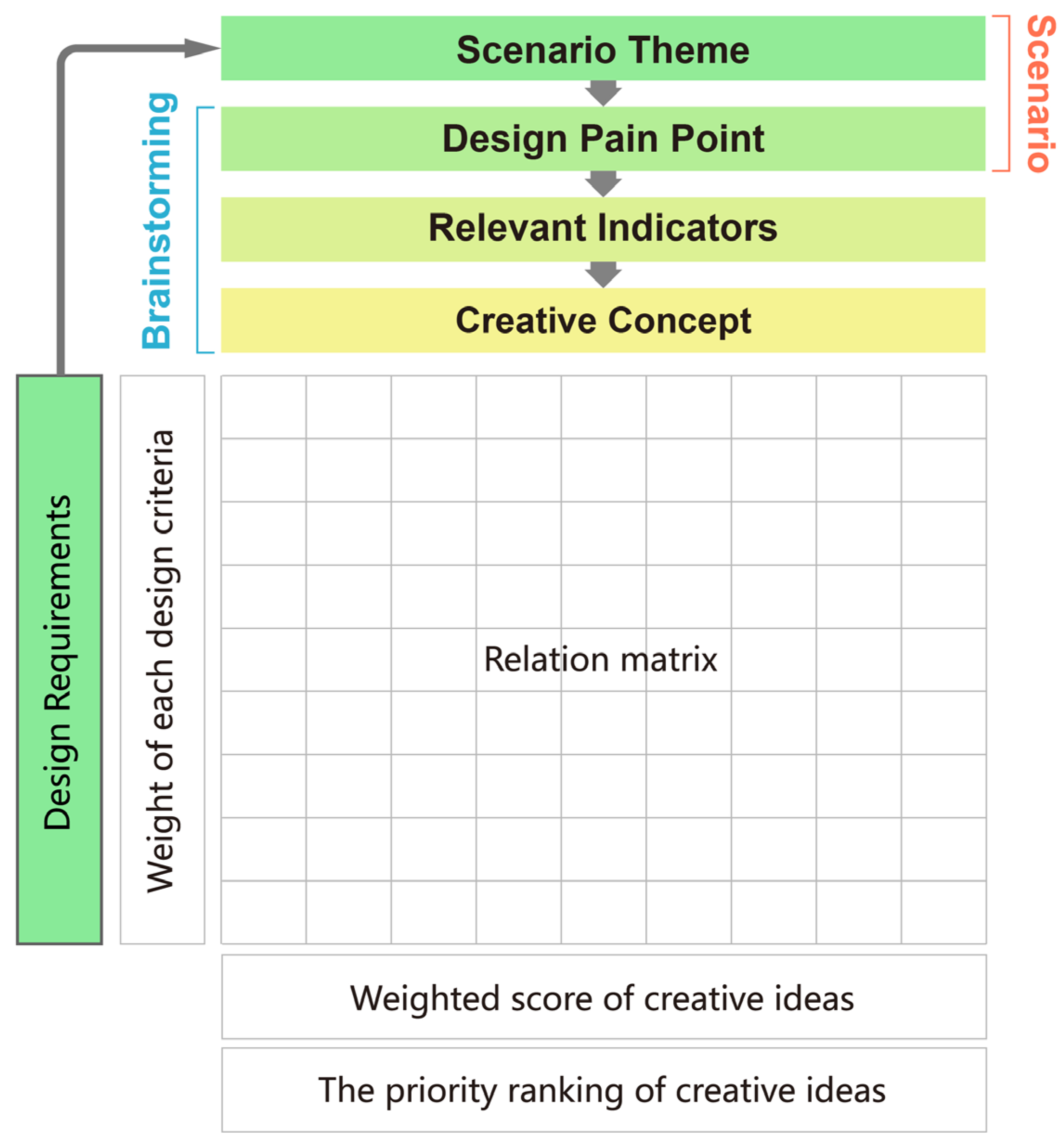
| Seven Principles and Three Supplementary Provisions | Thirty-Seven Universal Design Evaluation Indicators |
|---|---|
| Principle 1: Fair Use | UD 01 Equal use |
| UD 02 Eliminate feelings of difference | |
| UD 03 Offering choices | |
| UD 04 Eliminate anxiety | |
| Principle 2: Flexible Use | UD 05 Freedom of use |
| UD 06 Accepting left-handed and right-handed people | |
| UD 07 Proper use in emergency situations | |
| UD 08 Usability under changing conditions | |
| Principle 3: Simple and easy to understand | UD 09 Not overly complicated |
| UD 10 Intuitive to use | |
| UD 11 Easy to use and understand | |
| UD 12 Operating tips and feedback | |
| UD 13 Easy to understand structure | |
| Principle 4: Easy to identify information | UD 14 Provide multiple means of information transmission |
| UD 15 Processed obstacle operation information | |
| Principle 5: Allow for mistakes | UD 16 Considerations for preventing danger |
| UD 17 Preventing accidents | |
| UD 18 Ensuring safety even when used incorrectly | |
| UD 19 Even if you fail, you can return to the status quo | |
| Principle 6: Reduce physical strain | UD 20 Can be used in a natural posture |
| UD 21 actions that exclude meaning | |
| UD 22 Low physical load | |
| UD 23 No fatigue even after prolonged use | |
| Principle 7: Accessibility and operating space | UD 24 Maintain easy-to-use space and size |
| UD 25 Suitable for users of all body types | |
| UD 26 Caregivers can use it together | |
| UD 27 Easy to transport and convenient to store | |
| Supplementary provision 1: Economical for long-term use | UD 28 Consider using durability |
| UD 29 Reasonable price | |
| UD 30 Economy in continuous use | |
| UD 31 Easy to maintain and repair | |
| Supplementary provision 2: High quality and aesthetically pleasing | UD 32 Comfortable and attractive to use |
| UD 33 Satisfactory quality | |
| UD 34 Effective use of materials | |
| Supplementary provision 3: Harmless to humans and the environment | UD 35 Harmless to humans |
| UD 36 Harmless to the natural environment | |
| UD 37 Promoting recycling and reuse |
| n | 1 | 2 | 3 | 4 | 5 | 6 | 7 | 8 | 9 | 10 |
|---|---|---|---|---|---|---|---|---|---|---|
| R.I. | 0.00 | 0.00 | 0.58 | 0.90 | 1.12 | 1.24 | 1.32 | 1.41 | 1.45 | 1.49 |
| Design Requirements | Evaluation Indicators |
|---|---|
| A1 Fairness | b01 Accepting users of different age groups |
| b02 Accepting different gender groups | |
| b03 Accepting people with different physical conditions | |
| b04 Providing personalized choices and operational flexibility | |
| b05 Eliminate anxiety | |
| b06 Eliminate feelings of difference | |
| A2 Ease of use | b07 Easy to use and understand, not overly complicated |
| b08 Intuitive to use | |
| b09 Can automatically learn and optimize | |
| b10 Operating tips and feedback | |
| b11 Provide multiple means of information transmission | |
| b12 Organized and categorized operational information | |
| A3 Safety | b13 Preventing dangerous situations from occurring |
| b14 Focus on network security to prevent data leaks | |
| b15 Even if you fail, you can return to the status quo | |
| b16 Correct usage in emergency situations | |
| b17 Reduce repetitive movements | |
| b18 Reduce operational fatigue | |
| A4 Compatibility | b19 Different users and caregivers can jointly manage/use smart products |
| b20 The system’s operating methods and interface design are consistent with the user’s cognitive model | |
| b21 The shape, size, and layout of the product should be accessible to the user’s body structure and range of motion | |
| b22 The ability to exchange information with other systems or devices for data integration | |
| b23 The operating direction of the control device is consistent with the natural movement direction of the user | |
| b24 The response speed of the system or equipment matches the user’s perception of time | |
| A5 Sustainability | b25 Collect and recommend information appropriately based on user preferences |
| b26 Economy during continuous use (including durability and maintenance considerations) | |
| b27 Comfortable and attractive to use | |
| b28 Satisfactory quality | |
| b29 Harmless to humans and the environment | |
| b30 Promoting recycling and reuse |
| Expert No. | 1 | 2 | 3 | 4 | 5 | 6 | 7 | 8 | 9 | 10 |
|---|---|---|---|---|---|---|---|---|---|---|
| A1 | 0.098 | 0.067 | 0.192 | 0.293 | 0.263 | 0.217 | 0.102 | 0.253 | 0.254 | 0.075 |
| A2 | 0.256 | 0.182 | 0.275 | 0.099 | 0.242 | 0.249 | 0.393 | 0.142 | 0.256 | 0.293 |
| A3 | 0.470 | 0.377 | 0.253 | 0.280 | 0.278 | 0.270 | 0.327 | 0.430 | 0.366 | 0.464 |
| A4 | 0.086 | 0.174 | 0.146 | 0.068 | 0.105 | 0.100 | 0.060 | 0.099 | 0.056 | 0.086 |
| A5 | 0.091 | 0.200 | 0.134 | 0.259 | 0.112 | 0.164 | 0.118 | 0.075 | 0.069 | 0.081 |
| Expert No. | 1 | 2 | 3 | 4 | 5 | 6 | 7 | 8 | 9 | 10 |
|---|---|---|---|---|---|---|---|---|---|---|
| λmax | 5.240 | 5.305 | 5.318 | 5.124 | 5.438 | 5.173 | 5.193 | 5.422 | 5.435 | 5.039 |
| C.I. | 0.060 | 0.076 | 0.080 | 0.031 | 0.110 | 0.043 | 0.048 | 0.106 | 0.109 | 0.010 |
| C.R. | 0.053 | 0.068 | 0.071 | 0.028 | 0.098 | 0.039 | 0.043 | 0.094 | 0.097 | 0.009 |
| Design Requirements | A1 | A2 | A3 | A4 | A5 |
|---|---|---|---|---|---|
| Integrated weighting | 0.181 | 0.239 | 0.352 | 0.098 | 0.130 |
| No. | Theme | Application Scenario | Design Pain Points and Scenario Diagram |
|---|---|---|---|
| S1 | Mom’s health management assistant | Mrs. Chen is a full-time mother who is busy taking care of her family and her children’s diet and health. She uses this smart refrigerator to track the freshness of ingredients and plan daily menus. Mrs. Chen opened the touch panel on the refrigerator door and found that the application showed that the chicken label inside the refrigerator had turned yellow, indicating that it was about to expire. The refrigerator immediately sends a notification reminding her to use this batch of chicken today. She quickly checks the freshness status of other vegetables in the system to ensure she can pair them with healthy side dishes. She is grateful that this refrigerator helps her to manage ingredients effortlessly, avoid waste, and ensure that her family enjoys fresh, healthy meals. | 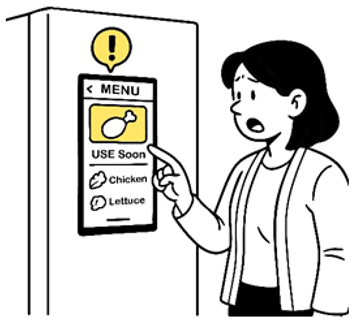 Traditional solutions cannot meet user needs. s1-1 automatically detects the shelf life of ingredients and provides timely reminders to avoid waste caused by forgetting. s1-2 provides ingredient pairing suggestions to help users quickly plan healthy meal plans. |
| S2 | Father’s remote collaboration | Mr. Zhang frequently travels for work, but he still wants to help his wife and children keep track of the contents of the refrigerator, especially the children’s snacks and daily healthy beverages. While working away from home, Mr. Zhang used a mobile app to remotely check the contents of the refrigerator and discovered that his children’s favorite yogurt was almost gone. He marked the yogurt with a reminder label and set up a notification to remind himself to buy new yogurt when he had time. On the other hand, his wife could also ask him to restock the fridge with new ingredients. This refrigerator allows Mr. Zhang to stay informed about the situation at home even when he is away, enabling him to interact and collaborate with his family. | 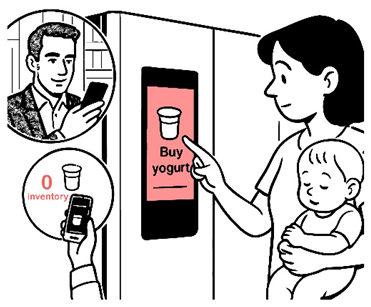 Traditional solutions cannot meet user needs. s2-1 supports remote real-time viewing of refrigerator contents, solving the problem of not being able to check the status of food ingredients when away from home. s2-2 sets tags and notifications to help family members to collaborate and reduce shopping omissions. |
| S3 | My daughter’s culinary creativity | Xiao Mei, the daughter of the Zhang family, is a high school student who loves cooking. She often creates new dishes based on the ingredients available at home. Xiao Mei gently taps on the refrigerator door, uses the scanning function to check what ingredients are left inside, and searches for remaining ingredients using the keyword search function on the touchscreen panel. She discovers some green peppers and steak, immediately clicks on the smart function to look up recipes, and begins creating a new dish. This refrigerator allows Xiao Mei’s culinary creativity to no longer be limited by whether she remembers what ingredients are in the refrigerator, enabling her to improvise based on the current availability of ingredients at any time. | 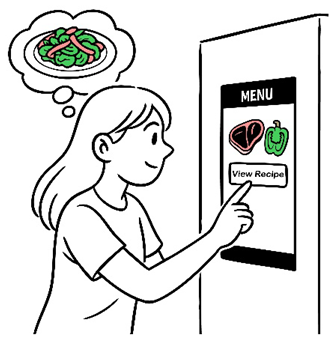 Traditional solutions cannot meet user needs. s3-1’s scanning and search functions make ingredient lists transparent, reducing the burden of memory and searching. s3-2 is paired with a recipe recommendation system to assist in improvisational cooking and enhance the cooking experience. |
| S4 | Grandparents who are not familiar with technology can use it without stress. | The Zhang family’s grandparents live together, but they are not familiar with smart devices and worry that a smart refrigerator might be difficult for them to operate. Before opening the refrigerator, when the grandmother touches the door handle, the refrigerator door displays information about the contents inside, allowing her to see at a glance which foods are still fresh. Since the interface is simple, the grandmother only needs to touch the panel to check the expiration dates of the ingredients and use or discard them based on color-coded labels. The smart refrigerator requires no complicated operations, and even if she ignores this information, it does not affect the operation. It does not change her usage habits, making her feel stress-free when using it, and also helps her reduce food waste. |  Traditional solutions cannot meet user needs. s4-1 features a simple and intuitive interface design, using color coding to help determine the freshness of ingredients. s4-2 employs touchscreen technology to reduce complex operations and lower barriers to use for the elderly. |
| S5 | Children’s breakfast reminder | Xiao Ming is an elementary school student who often forgets to eat breakfast in the morning due to his busy schedule, and his mother is concerned about his nutritional balance. His mother set up reminder tags for his breakfast foods (such as milk and bread) in the app. When Xiao Ming wakes up in the morning, the refrigerator automatically sends a notification to remind him, and the touchscreen clearly displays the location of the foods he needs for breakfast. This smart refrigerator’s thoughtful feature ensures that Xiao Ming can enjoy his mother’s carefully prepared breakfast every day before school. | 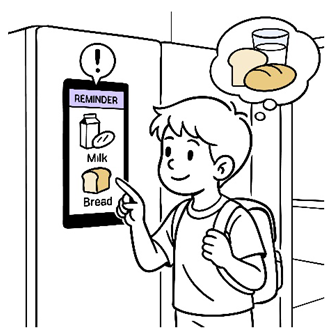 Traditional solutions cannot meet user needs. s5-1 automatically sends reminders to ensure that children do not skip breakfast. s5-2’s clear positioning on the touch panel allows children to quickly find the locations of ingredients. |
| Gender | Male | 22 (55%) |
| Female | 18 (45%) | |
| Age | 21–30 years old | 11 (27.5%) |
| 31–40 years old | 20 (50%) | |
| 41–50 years old | 7 (17.5%) | |
| 51–60 years old | 2 (5%) | |
| Education Level | University/technical college | 1 (2.5%) |
| Master’s degree | 15 (37.5%) | |
| Doctorate | 21 (52.5%) | |
| Others | 3(7.5%) | |
| Specialization Time | Within 5 years | 3 (7.5%) |
| 6–10 years | 14 (35%) | |
| 11–15 years | 12 (30%) | |
| 16–20 years | 7 (17.5%) | |
| Over 21 years | 4 (10%) |
| 1 | 0.576 | 0.032 |
| 2 | 0.729 | 0.020 |
| 3 | 0.677 | 0.024 |
| 4 | 0.528 | 0.035 |
| 5 | 0.576 | 0.032 |
| 6 | 0.506 | 0.037 |
| 7 | 0.541 | 0.034 |
| 8 | 0.524 | 0.035 |
| 9 | 0.546 | 0.034 |
| 10 | 0.420 | 0.043 |
| 11 | 0.663 | 0.025 |
| 12 | 0.503 | 0.037 |
| 13 | 0.653 | 0.026 |
| 14 | 0.660 | 0.025 |
| 15 | 0.589 | 0.031 |
| 16 | 0.633 | 0.027 |
| 17 | 0.551 | 0.033 |
| 18 | 0.466 | 0.040 |
| 19 | 0.512 | 0.036 |
| 20 | 0.433 | 0.042 |
| 21 | 0.565 | 0.032 |
| 22 | 0.512 | 0.036 |
| 23 | 0.501 | 0.037 |
| 24 | 0.418 | 0.043 |
| 25 | 0.637 | 0.027 |
| 26 | 0.433 | 0.042 |
| 27 | 0.526 | 0.035 |
| 28 | 0.365 | 0.047 |
| 29 | 0.685 | 0.023 |
| 30 | 0.648 | 0.026 |
| c1 | c2 | c3 | c4 | c5 | |
|---|---|---|---|---|---|
| 0.000 | 0.037 | 0.043 | 0.047 | 0.047 | |
| Standardization | 0.000 | 0.212 | 0.247 | 0.270 | 0.270 |
Disclaimer/Publisher’s Note: The statements, opinions and data contained in all publications are solely those of the individual author(s) and contributor(s) and not of MDPI and/or the editor(s). MDPI and/or the editor(s) disclaim responsibility for any injury to people or property resulting from any ideas, methods, instructions or products referred to in the content. |
© 2025 by the authors. Licensee MDPI, Basel, Switzerland. This article is an open access article distributed under the terms and conditions of the Creative Commons Attribution (CC BY) license (https://creativecommons.org/licenses/by/4.0/).
Share and Cite
Shieh, M.-D.; Hsiao, H.-C.; Chang, J.-F.; Hsiao, Y.-T.; Jhou, Y.-J. An AIoT Product Development Process with Integrated Sustainability and Universal Design. Sustainability 2025, 17, 8874. https://doi.org/10.3390/su17198874
Shieh M-D, Hsiao H-C, Chang J-F, Hsiao Y-T, Jhou Y-J. An AIoT Product Development Process with Integrated Sustainability and Universal Design. Sustainability. 2025; 17(19):8874. https://doi.org/10.3390/su17198874
Chicago/Turabian StyleShieh, Meng-Dar, Hsu-Chan Hsiao, Jui-Feng Chang, Yu-Ting Hsiao, and Yuan-Jyun Jhou. 2025. "An AIoT Product Development Process with Integrated Sustainability and Universal Design" Sustainability 17, no. 19: 8874. https://doi.org/10.3390/su17198874
APA StyleShieh, M.-D., Hsiao, H.-C., Chang, J.-F., Hsiao, Y.-T., & Jhou, Y.-J. (2025). An AIoT Product Development Process with Integrated Sustainability and Universal Design. Sustainability, 17(19), 8874. https://doi.org/10.3390/su17198874





